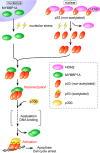The nucleolar protein Myb-binding protein 1A (MYBBP1A) enhances p53 tetramerization and acetylation in response to nucleolar disruption
- PMID: 24375404
- PMCID: PMC3931054
- DOI: 10.1074/jbc.M113.474049
The nucleolar protein Myb-binding protein 1A (MYBBP1A) enhances p53 tetramerization and acetylation in response to nucleolar disruption
Abstract
Tetramerization of p53 is crucial to exert its biological activity, and nucleolar disruption is sufficient to activate p53. We previously demonstrated that nucleolar stress induces translocation of the nucleolar protein MYBBP1A from the nucleolus to the nucleoplasm and enhances p53 activity. However, whether and how MYBBP1A regulates p53 tetramerization in response to nucleolar stress remain unclear. In this study, we demonstrated that MYBBP1A enhances p53 tetramerization, followed by acetylation under nucleolar stress. We found that MYBBP1A has two regions that directly bind to lysine residues of the p53 C-terminal regulatory domain. MYBBP1A formed a self-assembled complex that provided a molecular platform for p53 tetramerization and enhanced p300-mediated acetylation of the p53 tetramer. Moreover, our results show that MYBBP1A functions to enhance p53 tetramerization that is necessary for p53 activation, followed by cell death with actinomycin D treatment. Thus, we suggest that MYBBP1A plays a pivotal role in the cellular stress response.
Keywords: Cell Death; Nucleolus; Post-translational Modification; Stress Response; p300; p53.
Figures











Similar articles
-
Nucleolar protein, Myb-binding protein 1A, specifically binds to nonacetylated p53 and efficiently promotes transcriptional activation.Biochem Biophys Res Commun. 2013 May 10;434(3):659-63. doi: 10.1016/j.bbrc.2013.04.006. Epub 2013 Apr 11. Biochem Biophys Res Commun. 2013. PMID: 23583237
-
RNA content in the nucleolus alters p53 acetylation via MYBBP1A.EMBO J. 2011 Mar 16;30(6):1054-66. doi: 10.1038/emboj.2011.23. Epub 2011 Feb 4. EMBO J. 2011. PMID: 21297583 Free PMC article.
-
Novel nucleolar pathway connecting intracellular energy status with p53 activation.J Biol Chem. 2011 Jun 10;286(23):20861-9. doi: 10.1074/jbc.M110.209916. Epub 2011 Apr 6. J Biol Chem. 2011. PMID: 21471221 Free PMC article.
-
Cellular stress and nucleolar function.Cell Cycle. 2005 Aug;4(8):1036-8. doi: 10.4161/cc.4.8.1925. Epub 2005 Aug 20. Cell Cycle. 2005. PMID: 16205120 Review.
-
A new PICTure of nucleolar stress.Cancer Sci. 2012 Apr;103(4):632-7. doi: 10.1111/j.1349-7006.2012.02219.x. Epub 2012 Mar 8. Cancer Sci. 2012. PMID: 22320853 Free PMC article. Review.
Cited by
-
Long Noncoding RNA PURPL Suppresses Basal p53 Levels and Promotes Tumorigenicity in Colorectal Cancer.Cell Rep. 2017 Sep 5;20(10):2408-2423. doi: 10.1016/j.celrep.2017.08.041. Cell Rep. 2017. PMID: 28877474 Free PMC article.
-
Computational identification of new potential transcriptional partners of ERRα in breast cancer cells: specific partners for specific targets.Sci Rep. 2022 Mar 9;12(1):3826. doi: 10.1038/s41598-022-07744-w. Sci Rep. 2022. PMID: 35264626 Free PMC article.
-
Differential Integration of Transcriptome and Proteome Identifies Pan-Cancer Prognostic Biomarkers.Front Genet. 2018 Jun 15;9:205. doi: 10.3389/fgene.2018.00205. eCollection 2018. Front Genet. 2018. PMID: 29971090 Free PMC article.
-
p53- and ERK7-dependent ribosome surveillance response regulates Drosophila insulin-like peptide secretion.PLoS Genet. 2014 Nov 13;10(11):e1004764. doi: 10.1371/journal.pgen.1004764. eCollection 2014 Nov. PLoS Genet. 2014. PMID: 25393288 Free PMC article.
-
The Tumor Suppressor Roles of MYBBP1A, a Major Contributor to Metabolism Plasticity and Stemness.Cancers (Basel). 2020 Jan 20;12(1):254. doi: 10.3390/cancers12010254. Cancers (Basel). 2020. PMID: 31968688 Free PMC article. Review.
References
-
- Vogelstein B., Lane D., Levine A. J. (2000) Surfing the p53 network. Nature 408, 307–310 - PubMed
-
- Levine A. J. (1997) p53, the cellular gatekeeper for growth and division. Cell 88, 323–331 - PubMed
-
- Prives C., Hall P. A. (1999) The p53 pathway. J. Pathol. 187, 112–126 - PubMed
-
- Michael D., Oren M. (2003) The p53-Mdm2 module and the ubiquitin system. Semin. Cancer Biol. 13, 49–58 - PubMed
Publication types
MeSH terms
Substances
LinkOut - more resources
Full Text Sources
Other Literature Sources
Research Materials
Miscellaneous

